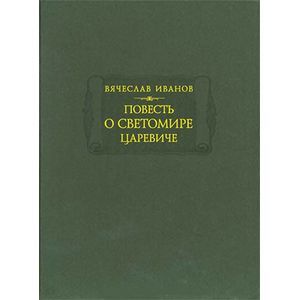Tale of Svetomir the Prince
Please sign in so that we can notify you about a reply
"Tale of Svetomir Tsarevich" is the last major work of an outstanding poet symbolist and thinker Vyach.Ivanov, his Magnum Opus, created during his Italian emigration.
The work is stylized under a medieval story or life and permeated fabulous and legendary motifs, is considered one of the most prominent works of Russian literature of the XX century.
"Tale" is focused on such ancient genres like a chronicle, non-canonic legend, apocrypha, partly and Western knightly romance. The story is conducted on behalf of a certain "elder-ink", as it should be in medieval literature, this old man Anonimem and is subordinated to a strictly developed verbal etiquette. Before us, as it were, the ancient Russian monument, but at the same time, as if the translation of this monument to a somewhat more modern language.
It is difficult to approach him - partly, it may be precisely because the verbal peculiarity hides from a direct view of the semantic laws of its construction. "Tale" multi-layer. Depending on the installation of the reader, it can be understood as a fairy tale, an adventure epic, a quasi-historical novel or theological treatise. It can be attributed to the samples of neomyphological art that is characteristic of our time, but it is rather rather not with the "Antimifami" of Joyce and Kafki, but with the "Joseph and his brothers" Thomas Mann or "Palcestial to the country of the East" Herman Hesse - that is, with the books of the post-holder , constructive, synthesizing warehouse. At the same time, as you know, the "story" is not completed.
Ivanov considered myth-making - passing into the theurgium - the basis and purpose of all major arts.
He treated other Russian symbolists to mythological models: in the first half of life, under the explicit effect of Nietzsche, - to the ancient mythology of the suffering of God, later - to what it is permissible to call Christian mythology (unlike Christian theology) The limit of his search was some synthetic world-thundering, in which the pagan myths turned out to be vague and approximate, but in their own deep and effective foresight of Christian dogmas.
The story is printed on the basis of manuscripts, preserved in the Roman archive of Vyach.Ivanov. For the first time, early sketches and plans, options from draft edits are published.
As accepted in the series "Literary Monuments", Tom includes a detailed article, exhaustive scientific comments, "main dates of life and creativity Vyach.Ivanov". The articles restored the creative story of the story, her literary context and artistic nature. In the comments, complex subtexts of the work, in particular, the formation of esoteric, kabbalistic and gnostic symbolism are revealed.
The publication includes many unique visual materials from the Roman archive of Vyach
The work is stylized under a medieval story or life and permeated fabulous and legendary motifs, is considered one of the most prominent works of Russian literature of the XX century.
"Tale" is focused on such ancient genres like a chronicle, non-canonic legend, apocrypha, partly and Western knightly romance. The story is conducted on behalf of a certain "elder-ink", as it should be in medieval literature, this old man Anonimem and is subordinated to a strictly developed verbal etiquette. Before us, as it were, the ancient Russian monument, but at the same time, as if the translation of this monument to a somewhat more modern language.
It is difficult to approach him - partly, it may be precisely because the verbal peculiarity hides from a direct view of the semantic laws of its construction. "Tale" multi-layer. Depending on the installation of the reader, it can be understood as a fairy tale, an adventure epic, a quasi-historical novel or theological treatise. It can be attributed to the samples of neomyphological art that is characteristic of our time, but it is rather rather not with the "Antimifami" of Joyce and Kafki, but with the "Joseph and his brothers" Thomas Mann or "Palcestial to the country of the East" Herman Hesse - that is, with the books of the post-holder , constructive, synthesizing warehouse. At the same time, as you know, the "story" is not completed.
Ivanov considered myth-making - passing into the theurgium - the basis and purpose of all major arts.
He treated other Russian symbolists to mythological models: in the first half of life, under the explicit effect of Nietzsche, - to the ancient mythology of the suffering of God, later - to what it is permissible to call Christian mythology (unlike Christian theology) The limit of his search was some synthetic world-thundering, in which the pagan myths turned out to be vague and approximate, but in their own deep and effective foresight of Christian dogmas.
The story is printed on the basis of manuscripts, preserved in the Roman archive of Vyach.Ivanov. For the first time, early sketches and plans, options from draft edits are published.
As accepted in the series "Literary Monuments", Tom includes a detailed article, exhaustive scientific comments, "main dates of life and creativity Vyach.Ivanov". The articles restored the creative story of the story, her literary context and artistic nature. In the comments, complex subtexts of the work, in particular, the formation of esoteric, kabbalistic and gnostic symbolism are revealed.
The publication includes many unique visual materials from the Roman archive of Vyach
Cover:
Cover:Other
Category:
- Category:History & Geography
- Category:Fiction
Series:
Series: Literary monuments
ISBN:
ISBN:978-5-86218-532-4
No reviews found
